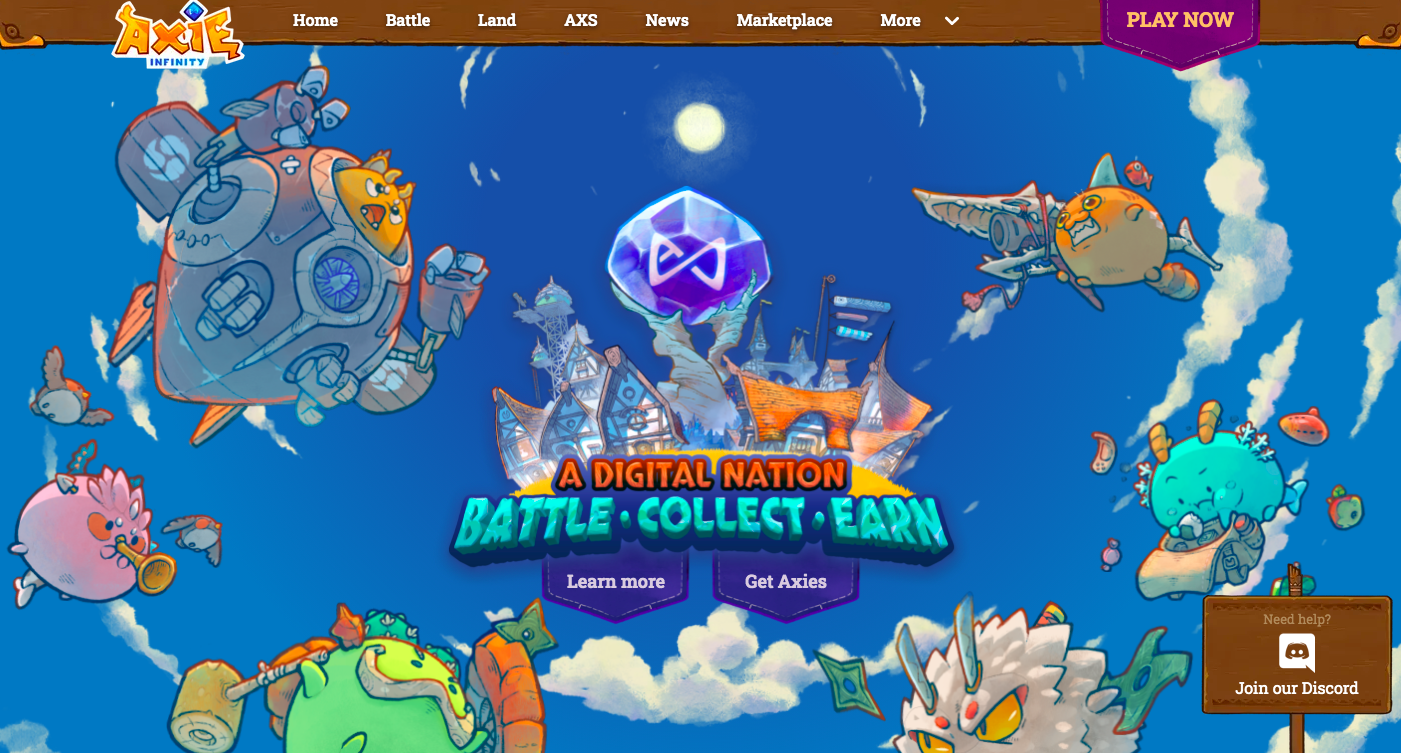When Axie Infinity, an NFT pet breeding game that allows players to earn money by spending time in the game, released its beta version in mid-2018, it was already a sensational hit. Pre-orders for its axolotl-inspired digital pets, called Axies, generated enough cash to give the developers a one-year runway.
Now, Axie Infinity is one of the world’s fastest-growing video games, with daily active users hitting 800,000 in July, up 4,900% from January’s 16,000. Its popularity is a wild success case for the play-to-earn gaming model, where players create financial value for themselves by trading digital commodities that are part of the in-game economy.
Created by Vietnam-based blockchain startup Sky Mavis, Axie Infinity marries the blockchain-tracked ownership of CryptoKitties with the competitive nature of games like Pokémon Go and Neopets. Users can make money by breeding and trading Axies, sending them into battle, or even building a land-based kingdom for their pets. All of these actions are applications that involve the deployment of non-fungible tokens, or NFTs, to create a fair economy and gameplay environment.
The meteoric rise of Axie Infinity presents a new opportunity for the video gaming sector—an industry that is set to exceed USD 200 billion in value by 2023, rising from 2020’s USD 155 billion—but video games that utilize blockchain remain niche. While Sky Mavis generates income from its Small Love Potion (SLP) utility tokens, its Axie Infinity Shard (AXS) governance tokens allow investors to vote on upgrades to the ecosystem and direct usage of a community treasury. The incorporation of tokens blends gaming with the crypto community, giving digital assets a use case that offers entertainment.
Axie Infinity‘s surging popularity has mounted pressure on the Ethereum network, a blockchain network that is the backbone of the game. “One issue that has been a perpetual thorn in our side is Ethereum network congestion. Network congestion is a tricky beast—with gas fees remaining low for months at a time only to resurface and slow our economy to a standstill,” the company said in a blog post last June.
This problem has forced the company to upgrade its scaling solutions to offer a fast, cheap, and seamless transaction flow. “We’ve been building the game steadily for three years, but it was only when we migrated our scaling solution—Ronin, an Ethereum sidechain network that was built specifically for blockchain games—that it became a big catalyst leading to the skyrocketing growth,” Axie Infinity’s head of growth, Jeffrey Zirlin, told KrASIA.
Read this: Thailand’s ban on NFTs and meme tokens increases regulatory risk in the industry
Sky Mavis draws revenue from Axie Infinity‘s players by charging them a 4.25% fee when they trade Axies on its marketplace. The company has made USD 287.65 million in the past seven days, making it the decentralized app project with the highest revenue in the world in this period, according to data from Token Terminal.
Introducing Ronin simplified the onboarding process for players who want to play Axie Infinity, but the volatility of cryptocurrencies remains a major concern for some players. To get started, each player has to acquire at least three Axies from the marketplace, but the minimum price for Axies has jumped from around USD 20 last November to USD 307 as of Monday morning, meaning a player now needs to put down more than USD 920 before they can begin playing the game.
When asked if this has hampered user acquisition, Zirlin said it is all about supply and demand. “It [the price] does increase the entry barrier, but we also have to keep in mind that Axies are priced based on the future expected resources and the value of those resources that can be earned with the different Axies,” he said.
The game is known for its play-to-earn feature, but the initial buy-in, no matter what the price point is, makes this game far from accessible to everyone. Zirlin said the firm will make it possible for new players to try the game for free. While players who sign on for the trial cannot earn money through their participation, the process will educate users about the game’s ecosystem as well as the complex cryptocurrency industry.
For Zirlin, the challenge now is finding ways to maintain the game’s large community and formulate actions to make it even more tight-knit. “A lot of it comes down to communication. Making sure that we are communicating with everyone in the network via Twitter or Discord is really important,” he said, adding that Axie Infinity barely invests in marketing, as their users have plugged the game through word of mouth.
The success of blockchain and NFT games like Axie Infinity has changed peoples’ perception of gaming, according to Zirlin. He believes the metaverse may offer new types of careers, adding that video games are one of the few industries where participation won’t be eliminated by job automation.
Animoca Brands, a Hong Kong-based blockchain gaming startup that hit unicorn status two months ago, is another rising star in the industry.
Yat Siu, chairman and co-founder of Animoca Brands, believes that the blockchain is set to herald a wave of economic changes. “At this time, the harsh reality for the vast majority of the USD 155 billion video game industry is that, regardless of how much you spend to acquire in-game assets, you don’t actually own them, are not allowed to make money from them, and could lose them at any time,” he said in a public letter posted on LinkedIn.
“This state of affairs is changing thanks to the fact that blockchain enables true digital ownership and play-to-earn in games, and this is triggering a wave of new economic opportunities,” he added.
Read this: Cybertino Lab launches NFT marketplace for influencers to create and trade digital assets
